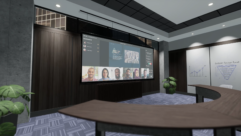A Sure Bet: Take advantage of the rich opportunities in the explosivegaming industry.
Jan 1, 1998 12:00 PM,
David Marsh
How long can it last? The rapid growth of casino gambling has manifestitself in an all out battle among the largest casino operators to “one-up”each other. Mega-resorts are being developed in Las Vegas and AtlanticCity, with new hotel towers and hotel expansions typically boasting 1,000to 3,000 rooms, huge casinos, convention facilities, race and sports books,showrooms and entertainment lounges. Outside the obvious Nevada and NewJersey developments, 22 other states currently allow casino gambling insome form. The July issue of Casino Executive magazine reported significantcasino developments in Arizona, California, Colorado, Connecticut,Illinois, Indiana, Iowa, Louisiana, Michigan, Minnesota, Missouri,Mississippi, North Carolina, Oregon, Washington and Wisconsin. The trendsof the past 10 years in the gaming and lodging market have resulted in agold mine of opportunities for systems contractors and consultants.
Trends in casino developmentAbout a decade ago, casinos began offering family-oriented entertainment,sometimes in Disney-style themed environments, targeting those members ofGeneration X who have settled into home and family life. Theme parks, videoarcades, shopping malls and babysitting catered to parents with smallchildren. However, this development had a tendency to draw people away fromthe casinos for too long. Safety for the children also became an issue. LasVegas learned that it had to get back to the basic business of entertainingadults and keeping them focused on gambling. There continues to be a trendtoward mega-resorts, focusing on the younger and uninitiated, but nowwithout the family emphasis.
The major casino operators are definitely betting on this mega-resort trendto work outside the realm of the Las Vegas strip. Examples are Steve Wynn’s$750 million Beau Rivage development in Biloxi, MS, and the Atlantis resorton Paradise Island in the Bahamas being built by Sun International.
Pelton Marsh Kinsella (PMK) is providing acoustical, theater andaudiovisual consulting services for the Beau Rivage project, which willinclude a 27-story, 1,800-room luxury hotel, convention facilities and ashowroom as well as an adjacent 500′ x 300′ (1,640 m x 94 m) floatingbarge. This enormous barge houses the casino, five restaurants and a brewpub as well as the pool and a large special events area on the barge roof.
The Atlantis resort on Paradise Island is literally doubling the size ofits existing complex to include a new casino and replacement of the old onewith convention facilities. There will be new restaurants, entertainmentvenues, pools, water slides and large aquariums themed to portray the lostcity of Atlantis. Audiovisual systems are being handled as a design-buildproject by the Orlando office of Soundelux Show Works in association withPMK. However, PMK has a separate consulting contract for the overallacoustical design and the convention center sound systems.
In contrast to the mega-resort trend is what Casino Executive magazinerefers to as “the era of elegance” in Las Vegas. Smaller, more intimate andhighly stylized venues, such as the new Monte Carlo hotel and casino, offerhigher-end services attracting more experienced gamblers who prefer thetable games. In these “elegance casinos,” attentive service will be thehook that keeps customers coming back.
The casino and convention industries have successfully fed off each otherin Las Vegas, continuing a trend to attract business and professionalorganizations. Many of the hotels have substantial convention and meetingfacilities, which obviously need audio and video systems. PMK recentlyprovided audiovisual consulting for the expansion of Caesars Palace in LasVegas, which includes a new hotel tower with ballrooms, meeting rooms,boardrooms, a health spa and Caesars’ executive offices. The project alsoincludes expansion of the casino, dining and retail spaces and a newfive-acre (two-hectare) outdoor pool area. The successful audiovisualsystems contractor for Caesars Palace was Ford Audio-Video, based inOklahoma City.
In an effort to combine the business and professional trend with the”elegance” trend, a developer called Seven Circle Resorts, based inSwitzerland, is building a resort northwest of the Las Vegas strip in anarea known as Summerlin. The Summerlin Resort, surrounded by golf courses,will include two small hotel wings, a casino, a race and sports book, ahealth spa and meeting facilities, all set in a country club environment.The main ballroom will have a small stage complete with theatricallighting, motorized curtain systems, rear-screen A-V projection and more tofacilitate corporate presentations as well as entertainment functions. Forthis project, PMK is providing acoustical, theater and audiovisualconsulting.
There seems to be endless opportunities for systems contractors andconsultants today in the gaming and lodging industry. Those interested inpursuing this work should visit Las Vegas and take notice of the followingsystems:
Broadband RF video distribution: Most large hotels these days offer cabletelevision and some form of pay-per-view movies. Other possible sources arestandard satellite, DSS and local programming, such as convention-relatednews programs). These signals are typically delivered to the guest roomsand other areas designated by the operator using an in-house cable TVsystem.
Background music and paging systems: Extensive background music (BGM) andpaging systems are usually needed throughout the casino, restaurants, poolareas, lobbies, elevators and other public areas. Multiple DMX channels canbe used to allow the operator to select different music for differentareas. The signal is typically distributed over 70 V speaker systems.Paging is best done through the telephone switch, but sometimes a simplepush-to-talk microphone is used. Selection of music source, paging zonesand other control functions may be simplified through use of touch-screencontrol interfaces, such as those manufactured by AMX and Crestron. Thisapproach was used at the Showboat Casino in Las Vegas. Because noise levelsin these areas vary considerably, it is also desirable to use automaticgain control based on ambient noise levels if the operator is willing topay for it. The BGM/paging front end at Caesars Palace entirely comprisesequipment manufactured by Innovative Electronic Designs (IED); thisequipment offers not only this type of automatic gain control, but alsodigital audio and centralized computer control with a point-and-click typeinterface.
Race and sports book audiovisual: Betting on horse races and other types ofsporting events takes place in the race book and sports book, respectively.The race book should have a seating area with rows of tables and chairsfacing the front of the room. The front wall should have projected video ofthe races on large screens and a number of video monitors below or adjacentto the screens. Sometimes, small monitors are also built into the tables inthe seating area. Each of these may be accompanied by a small loudspeaker,volume control and a switch integrated into a custom panel, which allowsthe person seated there to change the channel and watch any race ofinterest. The front wall of a sports book is similar, but the seating areawould not have long tables and individual monitors. LED matrix boards areoften used to display game scores, the odds and other information relevantto placing bets. A bar is often located in the sports book area, withmonitors showing the events of greatest interest.
Sound-reinforcement systems for live entertainment: Not every hotel-casinocomplex has a showroom. However, most of the larger ones offer some form oflive entertainment. This may take place in a dedicated entertainment loungeor simply in one of the casino bars equipped with a stage. The brew pub atBeau Rivage will have state-of-the-art sound, intelligent lighting andvideowall systems to support live music acts. Many of the showrooms arebuilt with a particular show in mind. As with scenery, the technicalsystems are designed for the show. The show-production company will havethe final say on system design. In fact, the company may even directly hirethe designers and contractors for sound and lighting systems. This setupsuggests a marketing approach for showrooms that is different from the oneused for other spaces mentioned in this article.
Audio and video systems for typical meeting spaces: The ballroom andmeeting room sound systems may be required to provide reinforcement of livevoice and music signals, paging, prerecorded program material and BGM. Indivisible rooms, each room section is served by a sub-system capable ofindependent operation or combined operation with adjacent rooms. Ideally,loudspeaker zoning and signal delay presets should be optimized for eachpossible room combination and for designated head-table or stage positionsas this aids listeners in “localizing” the sound at its source. It is bestto centralize this and other routing and control functions in a mastercontrol room. Use of tie-lines, patch panels and active routing andswitching can allow connections of all required audio and video signalsbetween any meeting spaces.
Budget and designThe owner’s budget will normally be a major factor in deciding whichloudspeakers to use, but it is safe to say that ballrooms will have higherquality sound than the smaller meeting rooms. At Caesars Palace, 12 inch(305 mm) coaxial loudspeakers from Radian are used in the ballrooms andlarger meeting rooms. The smaller meeting rooms and promenades are coveredby 8 inch (203 mm) coaxial loudspeakers manufactured by EAW and CDK,respectively.
Microphone and line-level audio as well as video and intercommunicationconnections are provided on wall panels located at typical head-tablelocations within the ballrooms and meeting rooms. Audio and video tie linesas well as intercom connections may also be found in the largest ballroomsto facilitate use of rented video cameras and projectors for imagemagnification.
Use of automatic microphone mixers can simplify setup and to ensure asatisfactory mix of voices for panel discussions and similar events. Incases where manual mixing is required, a small microphone mixer can besupplied by the audiovisual rental company and connected to one of the wallpanel line-level inputs.
A volume control panel is normally located near a doorway, preferablyadjacent to a service corridor, in each room section or non-divisible room.This function may be merged with other audio controls, such as BGM musicselection as well as projection screen controls and lighting controls on atouch screen control panel.
Ballrooms and large meeting rooms do not usually have permanently installedprojection systems becuase of the variations in audience configurations,image sizes and types of projection equipment needed. These situations areoften best accommodated by rental equipment from a contract A-V supplier.On the other hand, it is not unreasonable to specify permanent motorizedprojection screens for the smaller meeting rooms for which theconfigurations are fairly predictable.
Ante upWe’ve not even delved into many of the interests being expressed by today’scasino resort operators, such as boardroom audiovisual systems, audio-videoteleconferencing and broadcast infrastructure. Systems contractors andconsultants who are willing to risk the effort of investigation willprobably find odds in their favor.










